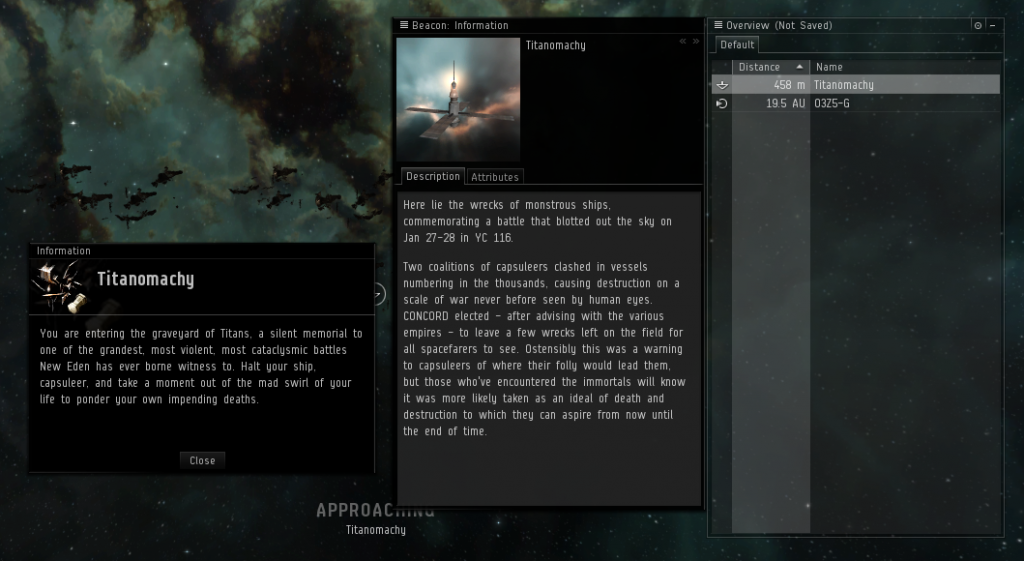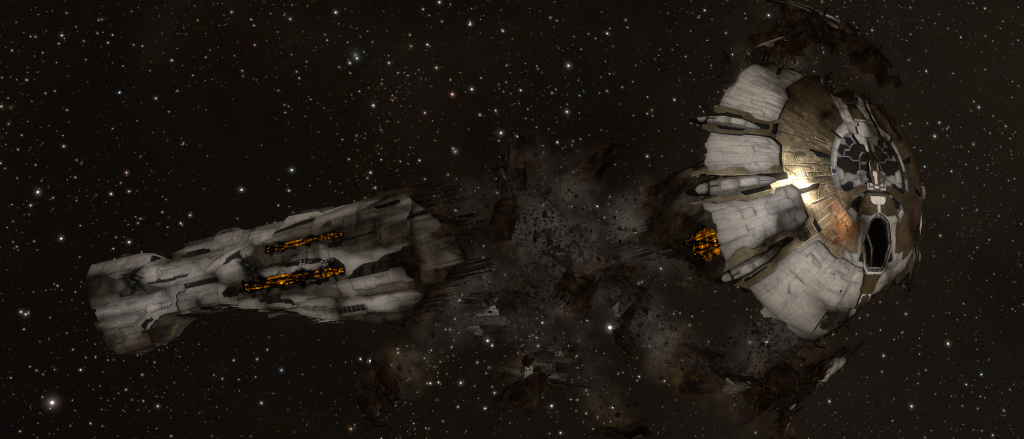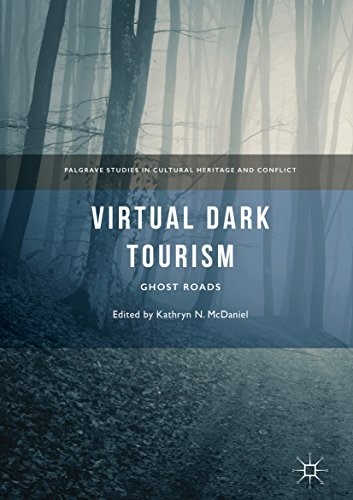The massively multiplayer game EVE Online is a story of intrigue, bitter rivalries, and endless conflict among the stars. To support the complicated fictional history of the game, the virtual space of EVE features historic sites and memorials that link to the fictional past and commemorate the continuing exploits of players, reinforcing a collective history that provides the sense of a narratively cohesive universe.
Over the course of approximately a year I explored the way history and war memory is treated in EVE Online as part of a book project that revolved around the idea of dark tourism, a relatively new field of study that examines travel to locations historically connected to death and tragedy. The focus of the collection was on the idea of “virtual” dark tourism, to “examine the purpose and influence of simulated travels to morbid sites.” 1 For my entry, I thought what better place to examine virtual dark tourism than in a fictional universe predicated on conflict and marked–or should I say scarred–by sites of battle and ancient tragedies. Dark tourism in EVE Online allows players to explore an uncertain collective virtual history on their own terms, to connect personal experience with the official narrative. In an unfamiliar world, tourism is a familiar way to engage with a fluid, fictional past. I also felt it was a step towards a longer term goal: understanding how history is utilized by game developers to create worlds that resonate with audiences and the impact of this usage upon the way players conceptualize the real and imagined past.

Dark tourism, whether or not we call it by that name, in woven into the fabric of national memory and the process of remembering the past. In the United States, the fields of Gettysburg, the Texas School Book Repository, and Alcatraz Island all speak to different ways to remember the past through an encounter with tragedy and violence. Closely related is the notion of “difficult heritage,” the public acknowledgement of past misdeeds by a people or government. For the United States, Wounded Knee or WWII Japanese Relocation Camps are two examples. Further related still are sites of morbid interest, as in Hollywood death tours or Jack the Ripper walks. In all cases, the attraction of sites of death and violence offers the opportunity to ask why do people seek to visit such places and what do visitors take away their encounters with the morbid past.
EVE Online proved a useful lens to examine the creation of dark sites and player responses to visiting the sites of fictional tragedies. Moreover, EVE‘s history is predicated on unending conflict. Given the limits on interactions available through the game engine and the predilections of the player base, the story of EVE is the chronicle of a history of violence. The vastness of a real world national history begets moments large and small that are remembered and commemorated in different ways. For EVE, conflict has framed the story so completely that the majority of sites within the game reflect war and destruction and that historical narrative is shown to the player through the shattered wrecks and broken space stations that litter the universe. EVE‘s developers have drawn upon the affective power of tragic events and real world memorials to construct sites within the game to build their own fictional past. In the starkest departure from real world sites of memory, EVE‘s dark sites seek to normalize and encourage violence by players within the game by constructing a grand narrative of aggression that indelibly colors the national narratives of the spaceborne nation-states of the game. Despite their varied backgrounds–religious theocracy, ostensible democracy, corporate state–the four player nation-states are referred to as empires, with all the connotations and trappings of imperial violence in their wars and in their state memory.

The idolization of violence is achieved due to the fundamental fact that EVE‘s dark sites lack one critical aspect of real world dark sites–true tragedy. Removed from actual death and suffering the dark sites of EVE reflect a sanitized vision of destruction, akin to a museum recreation. With this in mind, it was intriguing to see how the game developers intended for sites to impact a visiting player. The developers at CCP relied on the cues and markers of real world dark locations to create their own sites of memory. However, unlike dark sites of memory in the real world, the dark sites of EVE Online can and do evoke very different reactions from visitors. The message beacon located at the site of the Battle of R-R5BR succinctly sums up the disconnect.
“Ostensibly this was a warning to capsuleers of where their folly would lead them, but those who’ve encountered the immortals will know it was more likely taken as an ideal of death and destruction to which they can aspire from now until the end of time.“
Titanomachy beacon message.
Rather than reflection or sorrow, EVE‘s dark sites present a challenge to the player. For the player visiting a battlefield, this may manifest as a desire to have participated in the action. Destruction on a mass scale is aspirational within EVE Online. It is this moral inversion–shades of Star Trek‘s Mirror Universe–that defines the mentalities encouraged by a world defined by war. The fictional storyline of EVE compounds this distance from death. Players assume the roles of capsuleers, virtually immortal starship pilots. Death in the cold vacuum of space is a mere inconvenience for a player. If there is a cost, it is reflected in the loss of currency and material from a destroyed spacecraft. It is notable that the losses of the Battle of R-R5BR were measured in real world currency as news agencies attempted to parse the consequences of the conflict. Deeper within the fiction of the game is the assumption that the ships of EVE are crewed by regular humans, whose fate is rarely if ever addressed. The player has a twofold distance from the scenes of electronic death–as a player watching pixels explode and as an immortal for whom death is but a distraction. The history of EVE is great man history, where the machinations and strategic skills of players and NPCs What does this mindset do when players confront dark sites? How are dark sites engineered in-game to motivate players? These were some of the questions I sought to answer.


The essay saw print in 2018 as part of a volume of collected essays entitled Virtual Dark Tourism: Ghost Roads, published by Palgrave-McMillan and very ably edited by Dr. Kathryn McDaniel from Marietta College. While not peer reviewed, Dr. McDaniel had an anonymous reader go over the essay who offered suggestions and noted where clarifications were needed. This proved extremely useful, as I tried to keep the in-game jargon to a minimum while at the same time connecting the virtual dark tourism of EVE to real world antecedents. This is perhaps the most troublesome detail of working within virtual worlds: they possess their own jargon and terminology. Explaining the backstory of EVE was one thing. Explaining concepts such as nullsec space was another. 2 As a side note I particularly liked the subtitle Ghost Roads.
Writing an essay about the fictional history within a game world posted a unique set of problems. In-game research for the essay was greatly abetted by the rollout of the free to play Alpha clone state in 2016 but the complexity and hazards of EVE Online–not to mention the time required to train a character–made my virtual interstellar research trips problematic at best. To personally travel to distant sites was perilous as best due to aggressive players. That said, the difficulties in reaching dark sites in EVE due to cost and dangerous elements were factors that served to further connect virtual excursions to real world dark tourism.
Since the publication of Virtual Dark Tourism, I started graduate school at Michigan State University but I continued to think about the EVE project and ways to expand it. Thanks to a focus on digital history in my studies, participation in the Cultural Heritage Informatics Fellowship, and MSU’s overall strength in digital fields, I have been able to consider how to continue this investigation through this site using new digital tools. For this, the best medium is the digital, so I will be carrying out the exploration of strange new virtual worlds through this blog. If you’re curious about the original article itself, the book should be available in most university libraries. 3
Notes
1 From Virtual Dark Tourism: Ghost Roads.
2 Security level is a reference to how dangerous an area in EVE Online, shown by a number from -1.0 to 1.0. In high security space, the NPC police force CONCORD aggressively targets players who commit criminal actions, such as attacking other players. This provides a measure of security, although CONCORD focuses on attacking malfeasance and not protection. In null security space, 0.0 or lower, anything goes.
3 As full disclosure, I do not earn any royalties or other money from the book. However, I do believe it is an excellent collection of work on the manifold interpretations of the virtual and the role of dark tourism across imagined worlds.
References and Further Readings
–Daniel Fandino. “Remembering Fictional History and Virtual War in EVE Online” in Virtual Dark Tourism: Ghost Roads.
(I’ve referenced myself. I suppose this is a landmark somehow…)
–Phillip Stone. “A Dark Tourism Spectrum: Towards a Typology of Death and Macabre Related Tourist Sites, Attractions and Exhibitions.”
–John Lennon and Malcolm Foley. Dark Tourism: The Attraction of Death and Disasters.
–Sharon Mcdonald. Difficult Heritage: Negotiating the Nazi Past in Nuremberg and Beyond

